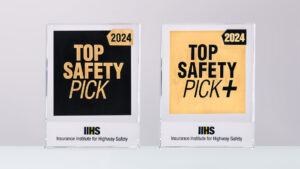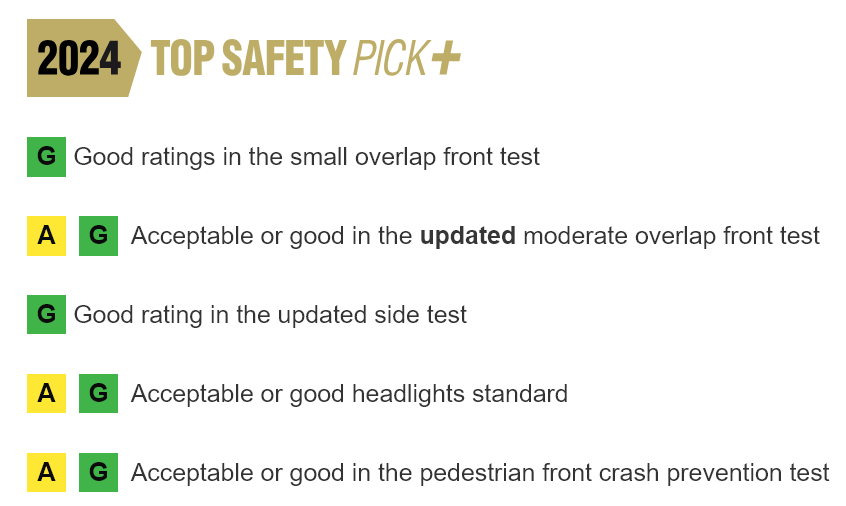
Despite more stringent IIHS criteria 71 vehicle models qualify for awards
By onAnnouncements
Thanks to updates made to back seat passenger and pedestrian crash avoidance system evaluation criteria it will be harder this year for automakers’ vehicles to earn the Insurance Institute for Highway Safety (IIHS)’s Top Safety Pick and Top Safety Pick+ awards.
IIHS says the more stringent criteria should challenge OEMs to make improvements, which several have already met.
Seventy-one models have qualified for the 2024 awards. Of those, 22 earned Top Safety Pick+ and 49 earned Top Safety Pick.
“We followed the tougher requirements we introduced last year with another major update to the award criteria in 2024,” said IIHS President David Harkey, in a news release. “This year’s winners are true standouts, offering the highest level of protection for both vehicle occupants and other vulnerable road users.”
Last year’s biggest change was the replacement of the original side crash test with an updated version that uses a heavier barrier traveling at a higher speed. Initially, an “acceptable” or “good” rating was enough to garner the lower-tier Top Safety Pick award. This year, a “good” rating is required for either Top Safety Pick or Top Safety Pick+.
Now, vehicles need an “acceptable” or “good” rating in a revised version of the pedestrian front crash prevention evaluation to qualify for either award. The new version replaces the earlier daytime and nighttime tests with a single evaluation that includes some test runs in daylight and at night.
Last year, vehicles could earn the lower-tier award regardless of whether they could detect and avoid pedestrians in the dark.
The updated moderate front overlap test has replaced the original evaluation in the 2024 Top Safety Pick+ requirements. Vehicles need an “acceptable” or “good” rating in the updated evaluation, which adds a second dummy seated behind the driver and emphasizes back seat safety. A “good” rating in the original moderate overlap test is still needed for the base Top Safety Pick award.
As before, to earn either award, a vehicle must offer good protection in a small overlap front crash in which 25% of the vehicle’s width on either side collides with another vehicle or a stationary object. This year, the driver-side and passenger-side evaluations have been combined into a single rating. The rating is equivalent to the lower of the two results.
Award winners also must have “good” or “acceptable” rated headlights on all trim levels.
Hyundai Motor Group received the most 2024 awards overall — six Top Safety Pick+ and 10 Top Safety Pick — followed by Toyota Motor Corp.
Toyota received one Top Safety Pick+ and 12 Top Safety Pick+ awards.
Mazda earned the most Top Safety Pick+ awards of any single brand with five. The OEM also received one Top Safety Pick.
By class, small SUVs, midsize SUVs, and midsize luxury SUVs are tied for the most Top Safety Pick+ awards with five each. Midsize luxury SUVs, which qualify for an additional 12 Top Safety Pick awards, earned the most awards overall.
Relatively few cars, pickups, and minivans qualify for either award.
“The high number of SUVs that earn awards probably reflects the dominance of those vehicles in the U.S. market,” said Harkey. “But it’s disappointing that only four pickups and four midsize cars earn awards, considering the popularity of those classes.”
IIHS introduced the original moderate overlap front test in 1995. At the time, most vehicles earned ratings of “poor” or “marginal.” For the past decade, virtually every vehicle tested has earned a “good” rating thanks to stronger vehicle structures, the introduction of front and side-curtain airbags, and a series of improvements in seat belt technology, IIHS said.
An analysis of 14 years’ worth of crash data involving IIHS-rated vehicles shows that a driver of a model rated “good” in the original moderate overlap test is 46% less likely to die in a head-on crash with a similar vehicle compared to a driver of a model rated “poor.”
IIHS said to encourage automakers to address that gap the updated test includes an additional dummy positioned in the second row behind the driver and uses new metrics that focus on the injuries most frequently seen in rear-seat occupants; many automakers have made substantial progress since the first group of ratings was released in December 2022.
Making an “acceptable” or “good” rating a requirement for Top Safety Pick+ is the next step in accelerating those improvements, IIHS said.
The tougher standards for pedestrian front crash prevention systems are grounded in similar progress, according to the release. In 2019, when IIHS launched the daytime vehicle-to-pedestrian evaluation, 21% of the vehicles tested earned the highest rating of “superior” while 44% of new models didn’t offer the technology. By last year, 59% of vehicles earned “superior” ratings in the daytime test. Forty percent also earned superior ratings in the nighttime evaluation, which was introduced a year earlier.
An advanced or superior rating in the daytime test was required for a 2023 Top Safety Pick award, and an advanced or superior rating in the nighttime test was necessary to earn the “plus.”
For 2024, IIHS has combined the two tests into a single evaluation, making nighttime performance essential for either award.
“There’s still progress to be made in the protection that vehicles provide for their occupants, as the introduction of the updated moderate overlap test shows,” Harkey said. “But many of the biggest gains of the future will come from automakers and policymakers, along with all of us as car buyers and drivers, taking steps to protect everyone on the road, not just our own families.”
Images
Featured image and chart provided by IIHS

